The creativity, storytelling, and emotional connections of brand marketing aren’t always associated with the business-to-business (B2B) marketing world. However, the broad consensus among B2B executives in a recent Boston Consulting Group study, conducted in collaboration with Google, is that brand marketing is increasingly critical to B2B organizations. In fact, those B2B companies that are best at brand marketing are unlocking significantly higher value and are at least twice as effective at achieving their marketing objectives as their less mature counterparts.
In August 2021, BCG surveyed 330 marketing leaders from seven B2B industries with a mix of business models. The vast majority of respondents called brand marketing essential for creating awareness (97%) and competitive differentiation (95%) for B2B businesses. Just as in the B2C world, it turns out, the human emotions of trust and a desire to be inspired play important roles in the B2B buyer’s journey. According to nearly all executives surveyed (99%), trust is an important component in B2B buying decisions, and 87% believe B2B products and services can be inspirational.
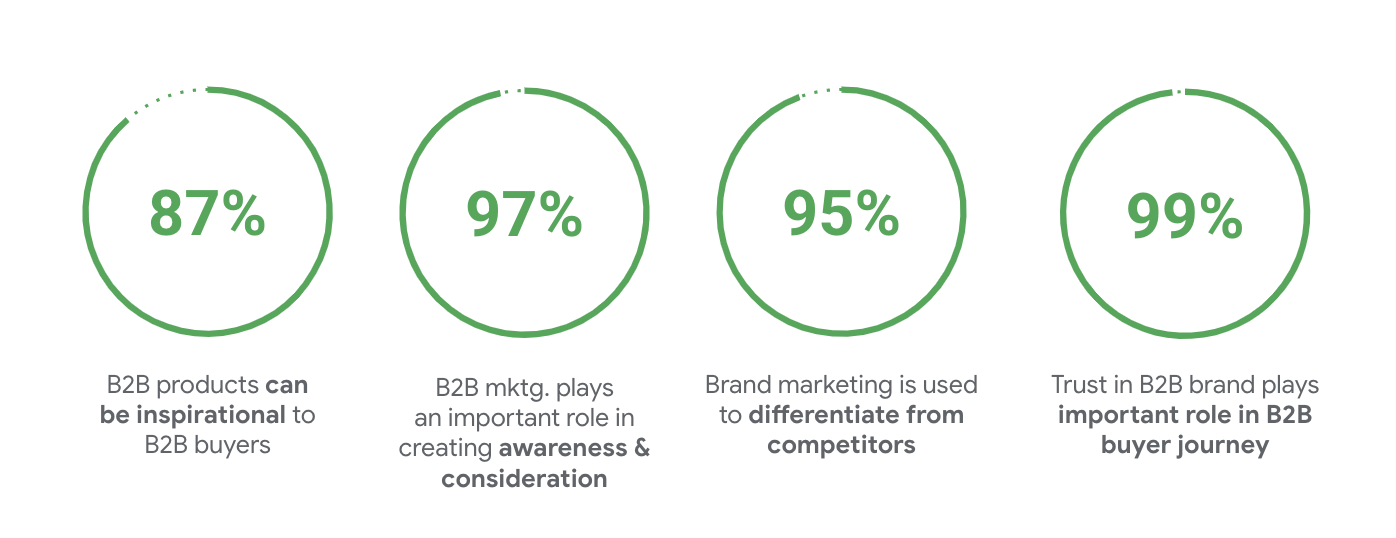
But the analysis also revealed low levels of brand marketing maturity among B2B organizations. More than half, in fact, lack a clear brand vision, ability to measure impact, and stakeholder buy-in.
By moving up the maturity curve, businesses can unlock concrete value at each step of brand marketing maturity. We’ve identified six best practices that more mature B2B brands are taking at the strategic, organizational, and technology levels that can help all B2B companies begin leveraging their brand marketing strategies to drive short- and long-term business impact.
The Value of Brand Marketing Maturity
In our analysis, only a slim minority of respondents (10%, whom we call “amplifying brands”) are following best practices across the following key areas of brand marketing by using:
- Clearly defined brand strategies and brand value propositions.
- Sophisticated trusted measurement.
- Cross-functional operating models.
- Diverse sets of skills across teams.
- Automated and integrated technology.
- Omnichannel activation that tells their brand stories consistently and cohesively across all channels and customer touch points.
The remaining majority of respondents were “emerging” (37%), “nascent” (27%), or “differentiating” (26%).
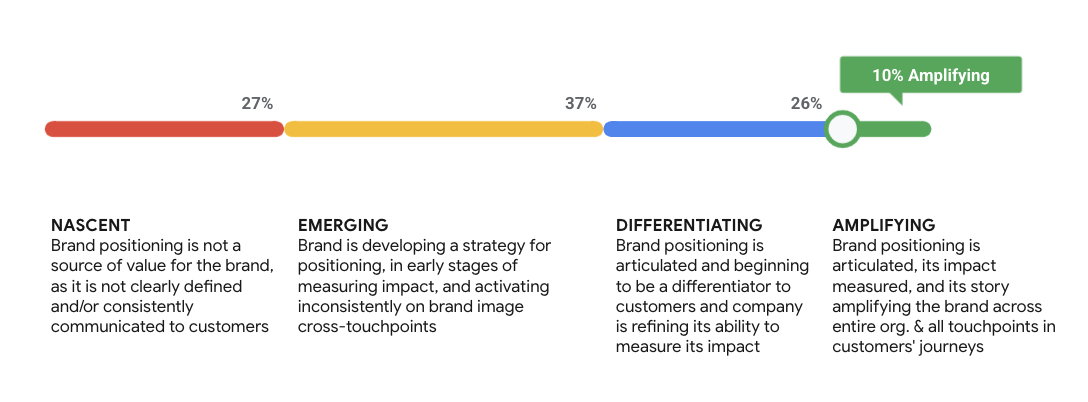
The value of climbing the maturity curve becomes clear when looking at the various groups’ return on investment (ROI) of paid media brand marketing expenditures. Even in the nascent group, ROI is surprisingly high, at 85%. ROI invariably increases, however, as maturity grows by an average of about 16% when moving from group to group. The ROI gap is most stark at the extreme ends of the maturity curve, with amplifiers realizing 54% higher ROI than the nascent group.
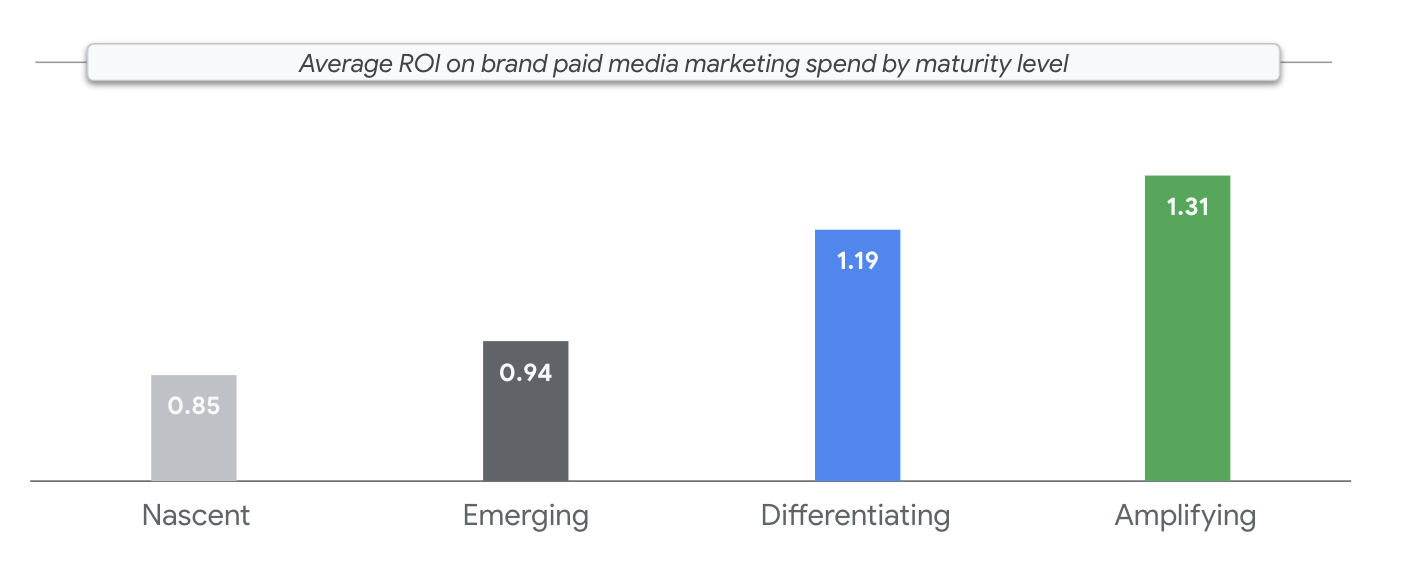
What’s more, while amplifying and nascent brands generally agree on the importance of brand marketing objectives, amplifying brands are two to four times more effective than their nascent peers. The gaps are greatest when it comes to increasing employee satisfaction and retention (425% difference between the two groups), boosting pricing power (420% difference), improving the ability to attract top talent (375% difference), and growing market share (300% difference).
Moving Up the B2B Brand Marketing Maturity Curve
Businesses can climb the maturity curve by recognizing what the leading B2B brand marketers are doing differently. Here are six steps for brand marketing success:
1. Develop a brand strategy. Above all, businesses need clear and consistent brand visions and powerful, differentiating value propositions. Amplifying brands, in fact, are twice as likely as the nascent group to view their brand value propositions as effective and powerful. This may be the result of how their marketing dollars are allocated. Amplifying brands spend 37% more of their marketing budget on “long-term goals” (goals with a timeline of greater than six months) than nascent brands do.
The balance in paid media marketing spend between brand and performance marketing is another factor. Amplifying brands spend equally between these two areas, whereas nascent brands dedicate about two-thirds of their budgets to performance marketing and about one-third to brand marketing. While the optimal balance will vary by industry, business model, and other factors, there is clear room for growth in brand spend for many nascent and emerging brands.
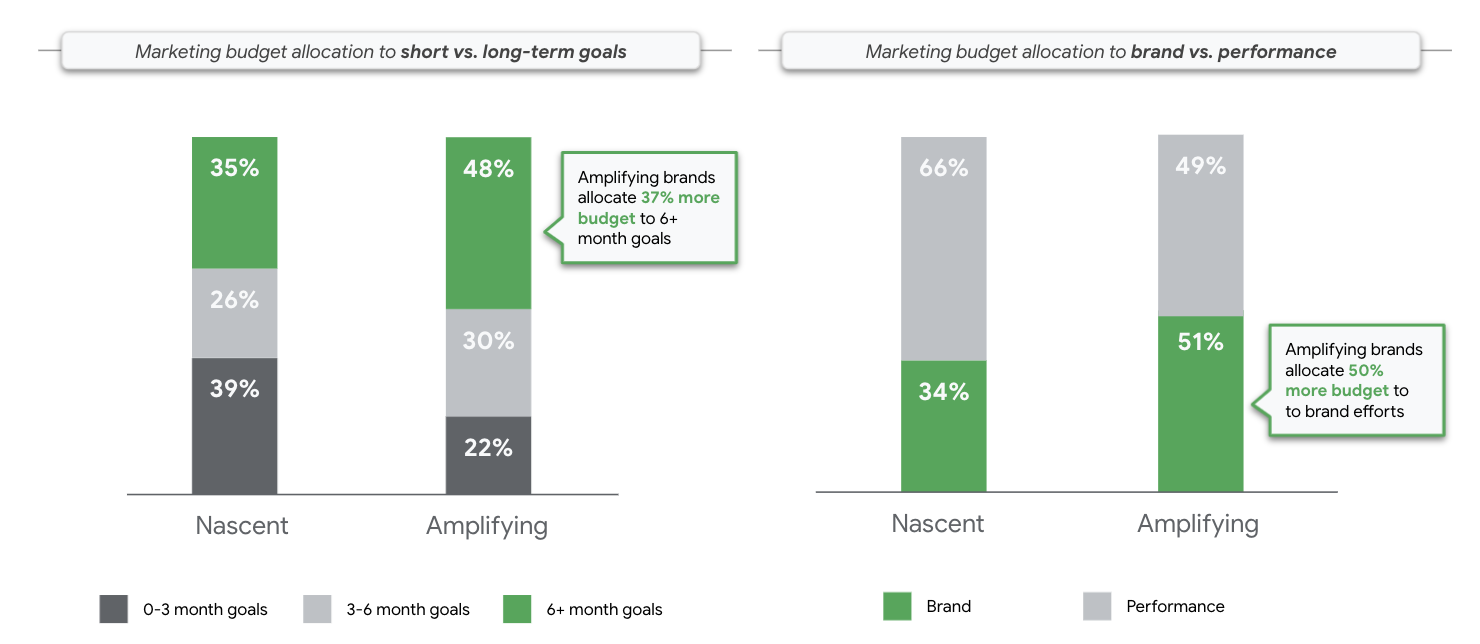
2. Apply actionable measurements. Brand marketing also requires different metrics than other types of marketing. Amplifying brands, in fact, have about 50% more key performance indicators (KPIs) than nascent brands and are significantly more likely to measure impact further down the funnel (for example, customer advocacy and loyalty). Once KPIs are set and measured, businesses also need to leverage the insights from them to drive change.
3. Acquire specialized skill sets. Brand marketing requires a diverse team that combines key skill sets, especially those related to creatively and effectively telling the brand story. While nascent brands invest in one or two skills on average, amplifying brands invest in an average of five skills, including creative management and customer segmentation.
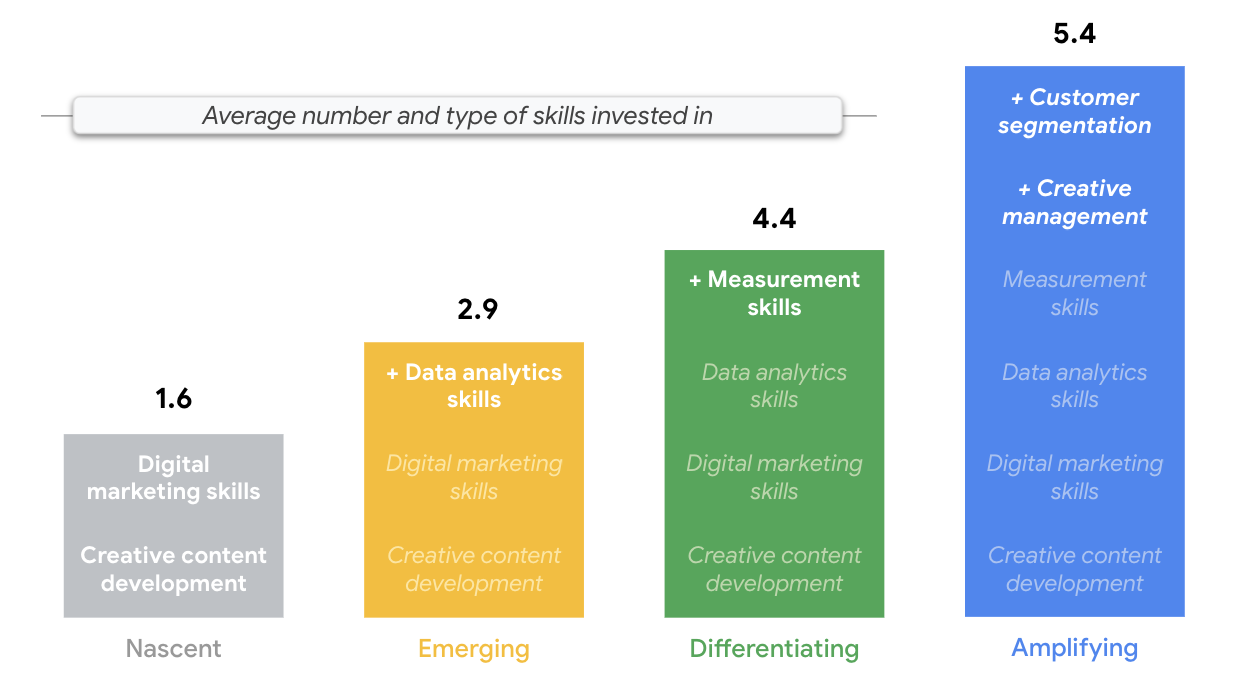
4. Use strong storytelling to support strategic activation. Mature brands consistently and effectively tell their brands’ stories across all customer touch points, including the later stages of the buyer’s journey. Compared with nascent brands, amplifying brands use about 225% more brand marketing for customer retention and loyalty.
A critical element to strategic activation is effective storytelling, specifically online. Amplifying brands were 46% more likely than nascent brands to have increased online video spend by more than 10% over the past three years. Across maturity levels, companies that invest more than half of their brand dollars in digital see roughly 25% higher returns.
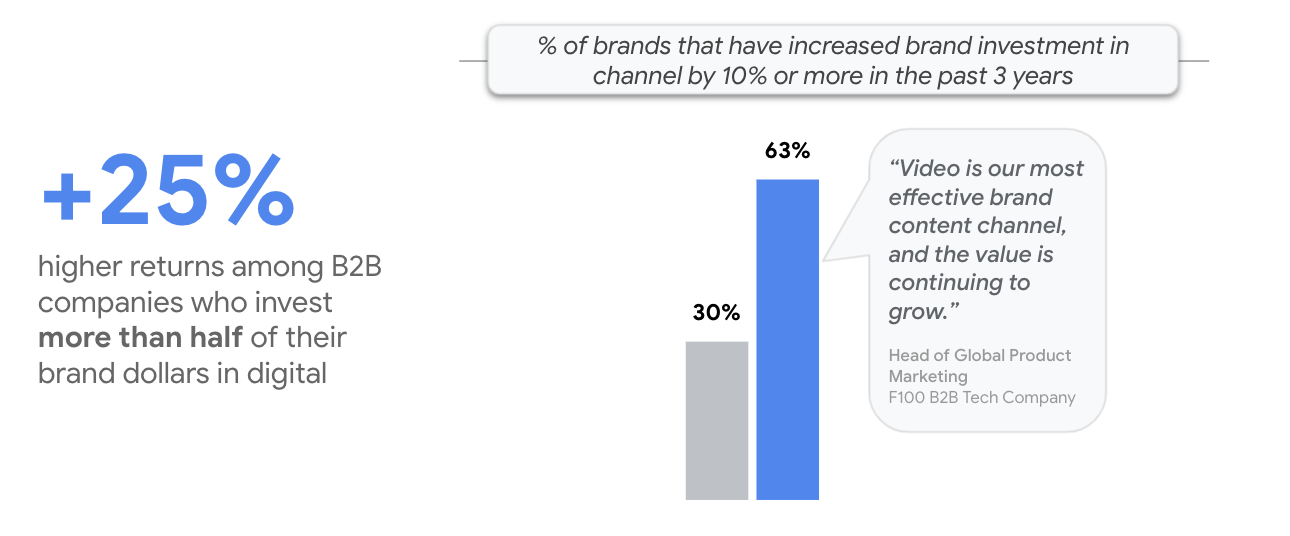
5. Adopt a cross-functional operating model. Amplifying brands take a fundamentally different approach to executing brand marketing. First, they tend to have larger, cross-functional teams, with an average of 47 full-time equivalents (FTEs) dedicated to branding, as opposed to nascent brands, which have an average of 23. Amplifying brands also tend to have:
- Cross-organizational teams working in an integrated manner toward specific objectives.
- Agile and innovative approaches that involve continuous testing and iterating.
- Flexible budgets with the ability to shift dollars as needed.
- Senior management buy-in.
- Streamlined processes to push brand content to all channels.
6. Implement automated and integrated technology. Amplifying brands have effective marketing technology infrastructures in key areas such as:
- Customer communications.
- Content development and digital asset management.
- Data management.
- Audience intelligence and analytics.
- Measurement and reporting.
They also have clear strategies for ensuring sufficient volumes of quality data, consistent data types and structures across countries and brands, and road maps to close data gaps.
Putting the Brand in B2B
As B2B customer expectations change, B2B brand marketing will only grow in importance. Those looking to keep up with competition should start by honestly assessing where they are now and where they want to go, putting those all-important road maps in place to achieve ambitious yet realistic goals.
By moving up the brand marketing maturity curve, B2B companies can realize more effective customer insight and engagement, deepen customer relationships, achieve higher ROI, enhance customer lifetime value, and support long-term customer retention and advocacy.

